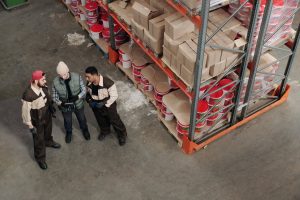The Difference Between X-Ray Machines And Metal Detectors In Food Inspection
June 7, 2022961 views0 comments

There are two main types of food inspection methods: x-ray machines and metal detectors. Both have their own advantages and disadvantages that make them better or worse for certain types of inspections. It’s important to know the difference between the two before choosing which one to use for your food inspection needs. Here is a brief overview of the differences between these two methods.
1. X-ray machines can detect smaller pieces of metal than metal detectors
X-ray machines use high-frequency waves to penetrate food products and detect smaller pieces of metal that might be embedded inside. Metal detectors, on the other hand, are only able to detect larger pieces of metal that are close to the surface. This means that x-ray machines are better at detecting small contaminants, such as metal fragments, while metal detectors are better at finding larger pieces of metal, such as coins or nails. Additionally, the X-Ray machine versus a metal detector discussion must consider that x-ray machines can also detect other things besides metal, such as glass or ceramic shards. If your food inspection needs require the detection of small contaminants, then an x-ray machine is the better option.
2. Metal detectors are less expensive than x-ray machines
X-ray machines are more expensive than metal detectors, both in terms of the initial purchase price and the ongoing maintenance costs. Metal detectors are also less likely to break down than x-ray machines, which means that they will need to be replaced less often. If cost is a major consideration, then metal detectors are the better choice. Additionally, some food inspection facilities use a combination of both x-ray machines and metal detectors to get the best of both worlds. This approach can be more expensive, but it may be worth the investment if your food inspection needs are particularly stringent.
3. X-ray machines can be dangerous
X-ray machines use ionizing radiation to penetrate food products, which means that they can be dangerous to operators if proper safety precautions are not followed. Metal detectors do not use ionizing radiation, which makes them much safer to use. If safety is a major concern, then metal detectors are the better choice. Additionally, x-ray machines must be carefully calibrated to ensure that they are not emitting too much radiation. This calibration process can be time-consuming and expensive, which is another downside to using x-ray machines. It’s important to weigh the risks and benefits of using x-ray machines before making a decision.
4. Metal detectors can be used for other purposes
Metal detectors can be used for a variety of purposes, such as security screening or detecting buried objects. X-ray machines are only able to be used for food inspection. If you need a versatile tool that can be used for multiple purposes, then metal detectors are the better choice. Additionally, some metal detectors come with built-in features that make them even more versatile, such as the ability to discriminate between different types of metals. This can be helpful if you only want to detect certain types of metals, such as iron or steel. It’s important to consider all of the potential uses for a metal detector before making a purchase.
5. X-ray machines provide a more detailed image
X-ray machines provide a more detailed image than metal detectors because they penetrate food products more deeply. This means that x-ray machines are better at finding small contaminants that might be embedded inside food products. Metal detectors, on the other hand, can only provide a surface image. If you need a detailed image of the food product, then an x-ray machine is the better option. Additionally, x-ray machines can be equipped with special filters that help to improve the quality of the image. It’s important to consider the image quality that you need before making a decision.
6. Metal detectors are portable
Metal detectors are more portable than x-ray machines, which means that they can be used in a variety of settings. X-ray machines are typically too large and bulky to be used in mobile settings, such as food trucks or outdoor events. If you need a food inspection tool that can be used in a variety of settings, then metal detectors are the better choice. Additionally, some metal detectors come with built-in wheels that make them even easier to transport. If portability is a major concern, then metal detectors are the way to go. It’s important to consider all of your needs before making a decision.
7. X-ray machines can inspect packaged foods
X-ray machines can inspect both packaged and unpackaged foods, which makes them more versatile than metal detectors. Metal detectors can only be used to inspect unpackaged foods, which limits their usefulness. If you need a food inspection tool that can be used on both packaged and unpackaged foods, then an x-ray machine is the better choice. Additionally, x-ray machines can be used to inspect other items, such as luggage or parcels. If you need a versatile tool that can be used for multiple purposes, then an x-ray machine is the way to go.
8. X-ray machines require special training to use
X-ray machines require special training to use because they emit ionizing radiation. This means that operators must be properly trained in order to use them safely. Metal detectors do not emit ionizing radiation, which means that they can be used without any special training. If you need a food inspection tool that can be used without any special training, then metal detectors are the better choice. Additionally, x-ray machines must be regularly serviced and calibrated by qualified personnel. This can be time-consuming and expensive, which is another downside to using x-ray machines. If you need a low-maintenance food inspection tool, then metal detectors are the way to go.

Both x-ray machines and metal detectors have their own advantages and disadvantages. It’s important to consider all of your needs before making a decision. If you need a detailed image, then an x-ray machine is the better choice. If you need a versatile tool that can be used in a variety of settings, then metal detectors are the better choice. If you need a tool that can be used without any special training, then metal detectors are the way to go. Ultimately, the best food inspection tool is the one that meets your specific needs.
